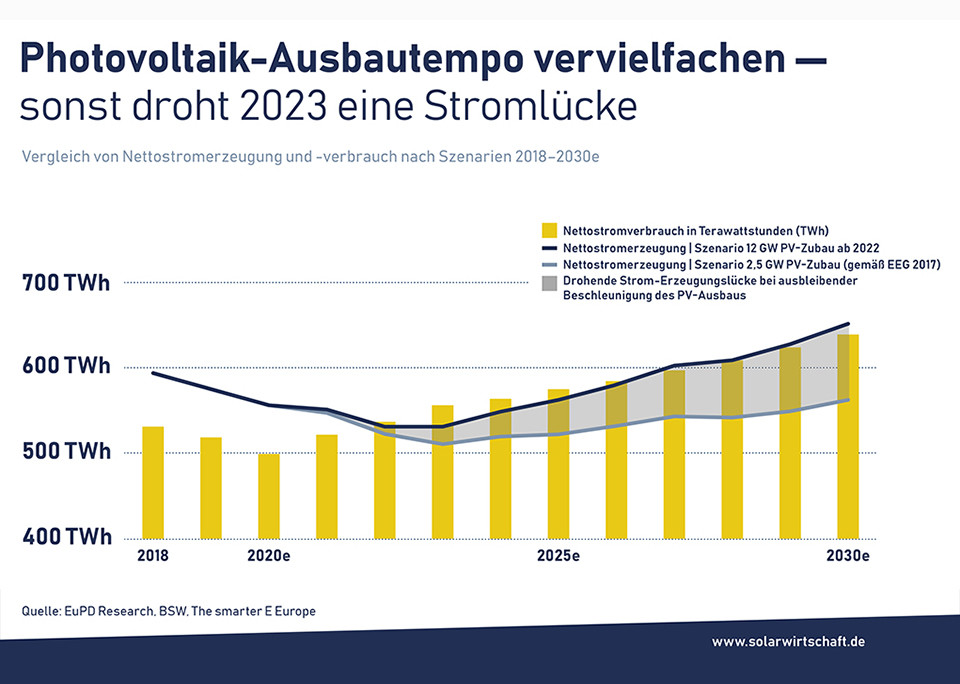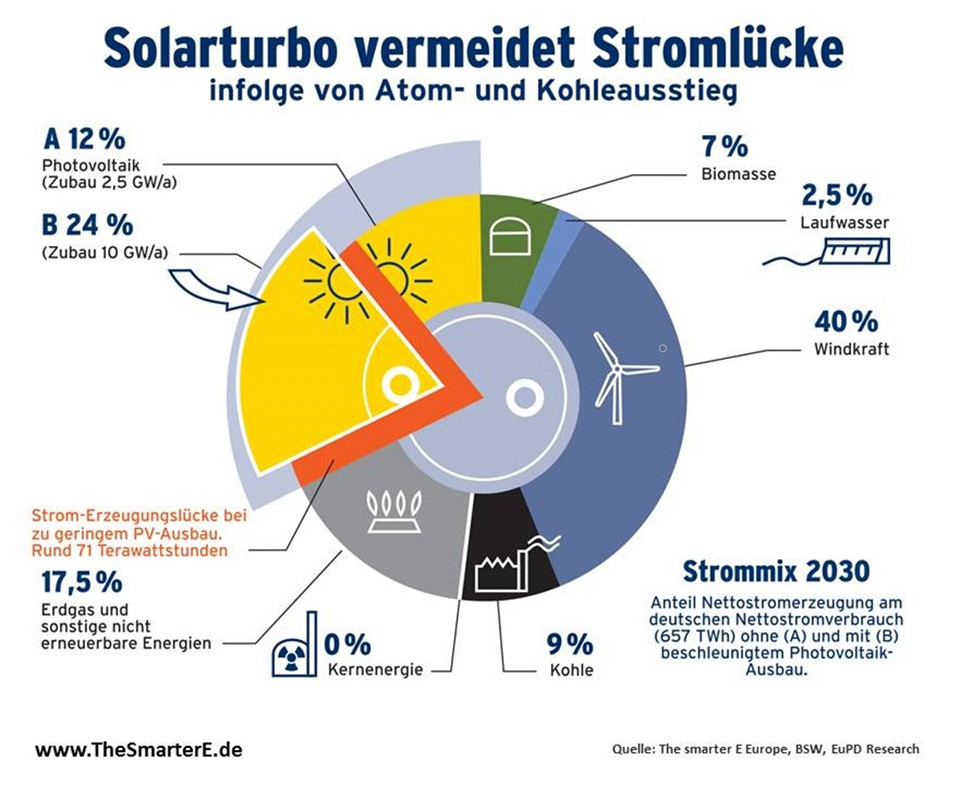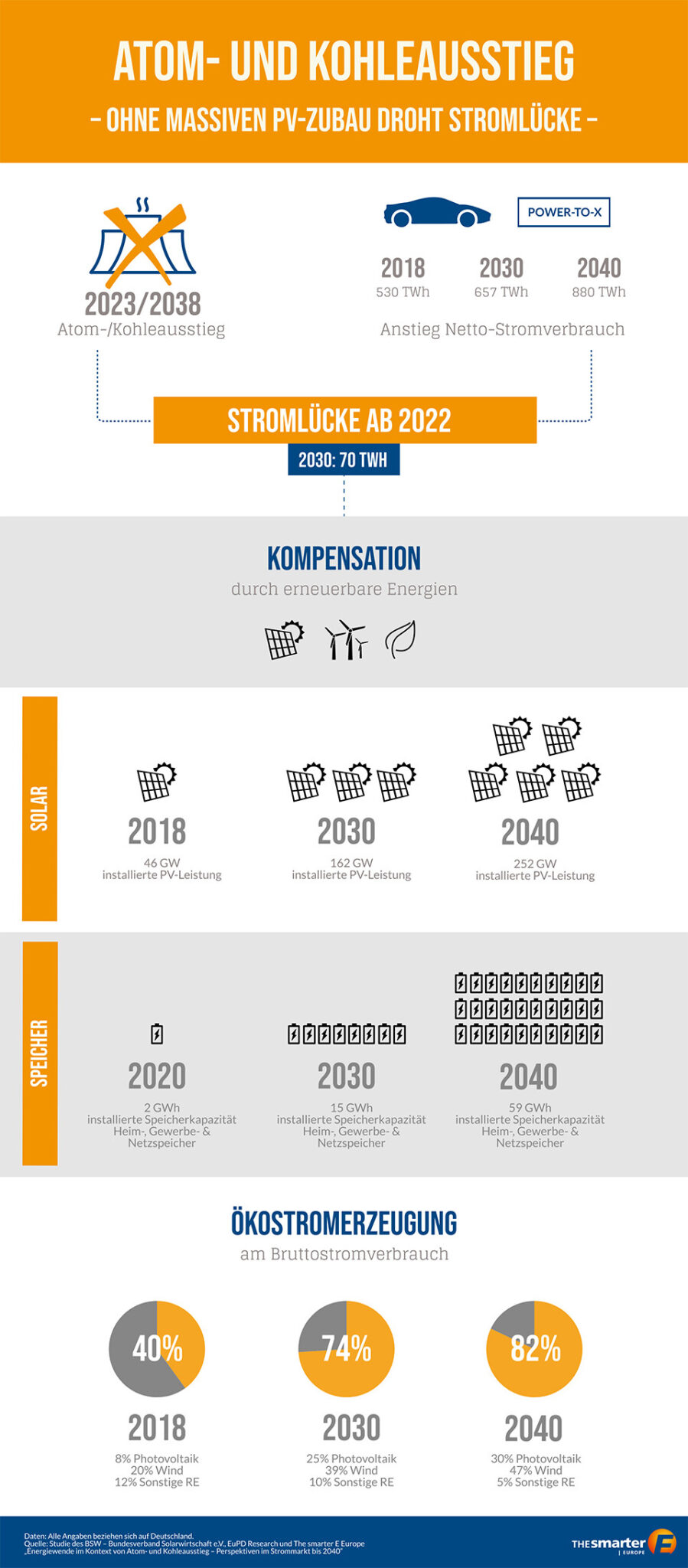Bald Stromlücke, trotz Corona-Krise – Soon power shortage, despite corona crisis
Sprachauswahl 📢
Veröffentlicht am: 18. August 2020 / Update vom: 12. Oktober 2021 – Verfasser: Konrad Wolfenstein
Das Photovoltaik-Ausbautempo muss vervielfacht werden, sonst droht 2023 eine Stromlücke. Vor dem Hintergrund der jüngsten gesellschaftlichen, wirtschaftlichen und politischen Entwicklungen hat das Bonner Markt- und Wirtschaftsforschungsunternehmen EUPD Research eine in Kooperation mit dem Bundesverband Solarwirtschaft und der Innovationsplattform The smarter E im letzten Herbst erstellte Studie aktualisiert.
The pace of photovoltaic expansion must be multiplied, otherwise there is a risk of an electricity shortfall in 2023. Against the background of the latest social, economic and political developments, the Bonn-based market and economic research company EUPD Research has updated a study prepared last autumn in cooperation with the German Solar Industry Association and the innovation platform The smarter E.
Marktforscher warnen vor einer Strom-Erzeugungslücke aufgrund zu langsamen EE-Ausbaus (Erneuerbare Energien) bei gleichzeitigem Atom- und Kohleausstieg – 2023 fehlen bereits 46 Terawattstunden – Verdreifachung des Photovoltaik-Ausbautempos kann Stromlücke verhindern – BSW: Ausbauziele der Regierung nach oben anpassen und solare Marktbarrieren beseitigen
Bonner Forscher warnen davor, dass bereits im Jahr 2023 eine Lücke in der deutschen Stromversorgung entstehen könne. Nur wenn das gegenwärtige Tempo des Photovoltaikausbaus ab 2021 verdoppelt und ab 2022 verdreifacht werde, könne die Versorgungssicherheit gewährleistet und die Klimaziele erreicht werden.
Als Auswirkung der Wirtschaftskrise infolge der Corona-Pandemie sagen die Marktforscher von EuPD Research für 2020 zwar einen Rückgang der Nettostromnachfrage um vier Prozent auf knapp unter 500 Terawattstunden (TWh) voraus. Prognosen zur wirtschaftlichen Erholung lassen aber bereits in 2021 einen stei- genden Stromverbrauch der Wirtschaft erwarten.
Infolge des Atom- und Kohleausstiegs und aufgrund eines nur schwachen Netto-Windenergieausbaus an Land werde die Stromerzeugung nach den Prognosen der Marktforscher spätestens in drei Jahren mit der anziehenden Stromnachfrage nicht mehr mithalten können. Trotz des stärkeren Zubaus von Windrädern in Nord- und Ostsee auf 20 GW in den kommenden zehn Jahren entstehe bereits im Jahr 2023 eine Stromerzeugungslücke in Höhe von 46 TWh. Diese wachse bis 2030 auf 77 TWh, was 12 Prozent des zu diesem Zeitpunkt erwarteten Strombedarfs entspricht (vgl. auch Grafik).
„Zur Vermeidung einer Stromerzeugungslücke muss der jährliche Photovoltaik-Ausbau von gegenwärtig rund 4 Gigawatt im Jahr bereits 2021 auf 8 Gigawatt verdoppelt und ab 2022 sogar auf 12 Gigawatt verdreifacht werden. Verbleibt hingegen der gesetzlich festgelegte Zubau für Photovoltaik bei 2,5 GW pro Jahr ergibt sich bereits in 2023 eine Stromlücke,“ kommentiert Dr. Martin Ammon, Geschäftsführer der EUPD Research, die Studienergebnisse. Carsten Körnig, Hauptgeschäftsführer des Bundesverbandes Solarwirtschaft appelliert daher an die Bundesregierung: „Es ist an der Zeit, die Ausbauziele im Erneuerbare- Energien-Gesetz entsprechend zu erhöhen. Gleichzeitig müssen alle Marktbarrieren für die Solartechnik endlich weg. Wer A sagt und zu Recht aus Atom- und Kohlekraft aussteigt und zugleich mehr Strom oder grünen Wasserstoff unter anderem in der Mobilität sehen möchte, der muss jetzt auch B sagen und den Ausbau Erneuerbarer Energien beschleunigen.“
„Wir sind mitten in einem umfassenden Wandel der Energiesysteme. Dieser Transformationsprozess braucht dringend verlässliche und klare politische Rahmenbedingungen – nur dann entstehen für Industrie, Handwerk und Gewerbe neue Wachstumsmöglichkeiten und zukunftsfähige Geschäftsmodelle“, ergänzt Markus Elsässer, Geschäftsführer der Solar Promotion GmbH und Initiator der wichtigsten Innovationsplattform für die neue Energiewelt The smarter E Europe.
Vor dem Hintergrund der jüngsten gesellschaftlichen, wirtschaftlichen und politischen Entwicklungen hat das Bonner Markt- und Wirtschaftsforschungsunternehmen EUPD Research die in Kooperation mit dem Bundesverband Solarwirtschaft und der Innovationsplattform The smarter E im letzten Herbst erstellte Studie „Energiewende im Kontext von Atom- und Kohleausstieg – Perspektiven im Strommarkt bis 2040″ im Juni 2020 aktualisiert.
Ziel der Studie war es, ein realistisches Zukunftsbild des deutschen Strommarktes zu entwerfen. Neben der Modellierung des deutschen Strommarktes werden volkswirtschaftliche Dimensionen des Umbaus sowie die Auswirkungen auf den Strompreis untersucht. Als Darstellungsebene fungieren Lastgänge und Erzeugungsprofile auf 15-Minuten-Basis. Der Modellansatz folgt dem sogenannten Zieldreieck der Energiepolitik aus Umweltverträglichkeit, Wirtschaftlichkeit und Versorgungssicherheit.
Market researchers warn of a power generation gap due to the slow expansion of renewable energies and the simultaneous phasing out of nuclear power and coal – 46 terawatt hours will already be missing by 2023 – Tripling the pace of photovoltaic expansion can prevent a power shortfall – BSW: adjust government expansion targets upwards and remove solar market barriers
Bonn researchers warn that a gap in the German power supply could already arise in 2023. Only if the current pace of photovoltaic expansion were to be doubled from 2021 and tripled from 2022 could security of supply be guaranteed and the climate targets achieved.
As an effect of the economic crisis caused by the corona pandemic, the market researchers of EuPD Research predict a decline in net electricity demand by four percent to just under 500 terawatt hours (TWh) in 2020. However, forecasts for economic recovery suggest that the economy will already start to consume more electricity in 2021.
As a result of the nuclear and coal phase-out and due to the weak net expansion of onshore wind energy, market researchers predict that electricity generation will no longer be able to keep up with the rising demand for electricity in three years at the latest. Despite the increased expansion of wind turbines in the North and Baltic Seas to 20 GW in the next ten years, there will already be a power generation gap of 46 TWh in 2023. By 2030, this gap will grow to 77 TWh, which corresponds to 12 percent of the electricity demand expected at that time (see also chart).
“To avoid a power generation gap, the annual expansion of photovoltaics must be doubled from the current 4 gigawatts in 2021 to 8 gigawatts and even tripled to 12 gigawatts from 2022. If, on the other hand, the legally stipulated expansion for photovoltaics remains at 2.5 GW per year, there will already be an electricity gap in 2023,” comments Dr. Martin Ammon, Managing Director of EUPD Research, on the study results. Carsten Körnig, Managing Director of the German Solar Industry Association, therefore appeals to the Federal Government: “It is time to increase the expansion targets in the Renewable Energy Sources Act accordingly. At the same time all market barriers for solar technology must finally be removed. Anyone who says A and rightly wants to get out of nuclear and coal power and at the same time wants to see more electricity or green hydrogen in mobility, among other things, must now also say B and accelerate the expansion of renewable energies”.
“We are in the middle of a comprehensive transformation of energy systems. This transformation process urgently needs reliable and clear political framework conditions – only then will new growth opportunities and sustainable business models emerge for industry, trade and commerce”, adds Markus Elsässer, Managing Director of Solar Promotion GmbH and initiator of the most important innovation platform for the new energy world The smarter E Europe.
Against the background of the latest social, economic and political developments, the Bonn-based market and economic research company EUPD Research has updated the study “Energy turnaround in the context of the nuclear and coal phase-out – prospects in the electricity market up to 2040”, which was prepared last autumn in cooperation with the German Solar Industry Association and the innovation platform The smarter E, in June 2020.
The aim of the study was to draw up a realistic picture of the future of the German electricity market. In addition to modelling the German electricity market, the economic dimensions of the transformation and its effects on the electricity price are examined. Load curves and generation profiles on a 15-minute basis are used as the presentation level. The modelling approach follows the so-called target triangle of energy policy consisting of environmental compatibility, economic efficiency and supply security.



























